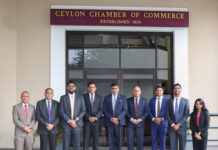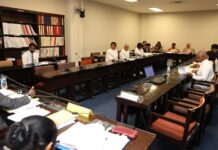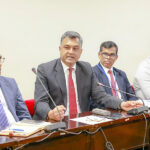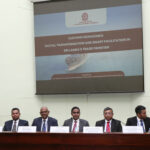The Ceylon Chamber of Commerce re-elected its leadership for the forthcoming year at its 183rd Annual General Meeting on 30 June, 2022.
The United States Ambassador to Sri Lanka Her Excellency Julie Chung attended as the Chief Guest.
Highlighting the Chamber’s concerted efforts toward national economic policy reform, Mr. Vish, Govindasamy, re-elected as Chairman of the Chamber for the year 2022/23, expressed appreciation for USA’s multifaceted support for Sri Lanka’s economic recovery and socio-economic progress, and invited Ambassador Chung to address the gathering.
The Ambassador’s speech, in its entirety, is reproduced below:
“Chairman Govindasamy, CEO de Silva, honorable members of the board, and friends at the Ceylon Chamber of Commerce – thank you for the invitation to speak with you this evening. I understand this is the first time in three years you’ve been able to hold this General Meeting in person – and how wonderful it is to see you all in person and not on a screen! As the Chairman just spoke about all the Chamber’s activities, I want to applaud your leadership in entrepreneurship, transparency, good business governance, and strong CSR (Corporate Social Responsibility). All of you in this room are not only spectators but real advocates for strengthening the investment and trade climate, and democratic institutions in Sri Lanka to make this country better.
Yesterday, a high-level delegation representing the U.S. Department of the Treasury and the U.S. Department of State just concluded an important visit. Deputy Assistant Secretaries Robert Kaproth of Treasury and Ambassador Kelly Keiderling of State met with a wide range of political representatives, economists, and international organizations. The purpose of their meetings was to explore the most effective ways for the United States to support Sri Lankans in need, Sri Lankans working to resolve the current economic crisis, and Sri Lankans planning for a sustainable and inclusive economy for the future. The delegation also pressed upon the government the need to negotiate urgently with its creditors and the IMF to finalize an assistance package, in order to ease the suffering of the Sri Lankan people and get the economy back on track as quickly as possible.
This visit underscores our ongoing commitment to the security and prosperity of the Sri Lankan people. Our efforts to support economic growth and strengthen democratic institutions have never been more critical.
As we all know, Sri Lanka is facing one of the most challenging moments in its history. We’ve all seen the fuel queues grow longer, and prices for basic necessities increase. We’ve sat in the dark during power cuts, and we’ve witnessed Sri Lankans voice their frustrations in peaceful protest. Every day, in every conversation I have, Sri Lankans share that they are worried about the future and the wellbeing of the next generation. Sri Lanka’s challenges are undoubtedly serious. But they are not insurmountable.
Every day, I see and hear examples about incredible ingenuity and inspirational efforts that are contributing to the well-being of every-day Sri Lankans. There is one thing I am certain about and that is the resilience of the Sri Lankan people. It will take creativity, leadership, determination, and compromise to resolve this economic crisis. It also requires political stability and urgent action. Now is the time to redouble our joint efforts to get Sri Lanka back on the path to economic stability. Now more than ever the private sector can make a difference in creating a more inclusive and sustainable economy. In my remarks today, I’d like to lay out a few – well, five to be exact, steps that I think Sri Lanka must take to revive its economy and build long term solutions to benefit all Sri Lankans:
First, the debt crisis must be resolved. We welcome the steps Sri Lanka has taken to go to the IMF, to hire debt and legal advisors, and begin debt restructuring talks. Those are positive moves. But there is much more that needs to be done to get Sri Lankan back on the path to sustainable economic growth. If talks are successful, this will be Sri Lanka’s 17th IMF package. Let’s make sure it’s the last. The reform measures Sri Lanka adopts need to address the root causes of this crisis so that the country finally makes lasting and decisive structural reforms that enshrine international standards of good governance and transparency for the benefit of all Sri Lankans. There is no more room for stop-gap measures.
As Sri Lanka engages in debt restructuring and financial reforms, it is absolutely critical that all creditors are treated equitably and comparably. That is one of the very important components that many countries who undergo an IMF program have to address.
Second, Sri Lanka must invest in its people. It is vital to have a workforce with gender parity, with women literally at the table and in leadership roles. Looking around this room, it’s clear we need more women in business and our work is not yet done. Women should enjoy equal access to funding for their small and medium-sized enterprises that operate in so many villages and towns across the island. It is imperative that all Sri Lankans have access to quality public primary, secondary, and tertiary education, and training so that Sri Lanka retains and builds on the rightly earned reputation of having a highly educated, creative, and skilled workforce. To build peace and stability, Sri Lanka must protect democratic values such as the rule of law, respect for human rights for all, equal representation, and transparent government. When these democratic values falter, the private sector, civil society, and the independent press must hold the government accountable for its leadership and stewardship of this country. The right to peaceful protest must be upheld for all Sri Lankans and the culture of impunity must end. We call on the government to foster independent institutions that operate transparently and build public trust in the reconciliation process, to ensure all Sri Lankan’s have access to a fair justice system, including further reforms to bring the PTA in line with international standards, and to engage with minority parties and a wide range of civil society organizations to bring political stability to the country. We also call upon the government to protect civic space and allow civil society organizations to operate freely. Economic reform needs to be intertwined with political reform in order to create a sustainable and prosperous economy for all of Sri Lanka’s people.
Third, the business environment and investment framework environment need improvements for the private sector to flourish. It is important to reduce red tape and make sure that there are no unreasonable obstacles to investors as they look for opportunities in Sri Lanka and bring in the foreign capital that the country desperately needs.
In 2020, U.S. foreign direct investment in Sri Lanka was $13 million, bringing total active U.S. investment in the country at the time to $274 million. If you compare this to the $17 million invested five years earlier in 2015, I think you would agree when I say that there is room for improvement. Concerns about consistency and transparency in government decision-making, and above all, a lack of predictability, are the primary reasons FDI hasn’t grown faster. What our companies want is a level playing field. A good regulatory framework. Trust that their arbitration and their contracts will be honored. When you have that kind of strong investment climate, then companies will want to come. Making this a reality, however, will require difficult decisions on reforming unprofitable state-owned enterprises that often pose a barrier to entry to foreign direct investment. We welcome the Ministry of Power and Energy’s recent efforts to modernize the country’s electricity sector to allow more private sector participation and diversity of energy sources.
Fourth, Sri Lanka should seize this moment to shift to green technology and renewable energy sources. We are encouraged by Sri Lanka’s target to reach 70 percent of electricity generation from renewable sources by 2030 as part of a broader policy of climate action. If there is anything the fuel crisis has taught us is that the time to switch to renewables is now! This is an area where Sri Lanka stands to benefit from the cutting-edge technology that American companies have to offer, as well as access to U.S.-based project finance. Clean power is also a priority focus of the Build Back Better World partnership that President Biden announced with our G7 partners last year.
Sri Lanka is endowed with abundant sustainable energy sources like wind and sunlight, but its power sector has not been developed to maximize the usage of these resources. This is why we launched the $19 million USAID Sri Lanka Energy Program to help transform Sri Lanka’s power sector into a sustainable and reliable market-driven system. The project will facilitate access to capital and attract investments in support of the government’s renewable energy goals. USAID’s Transaction Advisory Fund has committed $850,000 to support the competitive development of Floating Solar installations. The project will also work toward improving energy efficiency and demand side management activities in the country and will promote the deployment of advanced technologies.
We also recently announced technical assistance to VEGA Innovations to help them further develop Sri Lanka’s electric vehicle sector. This will support VEGA Innovations’ efforts to promote electric vehicles, including electric “tuk tuks,” help pilot a national vehicle charging network, and support the manufacturing of locally designed batteries and inverters. I drove one myself and was amazed by its efficiency; I can imagine a day when the streets of Colombo are full of these tuk tuks. The eventual transition of the Sri Lankan power sector to a market-driven system will provide more opportunities for Sri Lankan private businesses as well as international investors while helping the country get out of this crisis and rebuild its economy. This kind of financial assistance often contributes much more to long term, sustainable capacity development than more high profile, but economically dubious, infrastructure projects.
And finally fifth – and this is an area my team and I are truly excited about – Sri Lanka can grow its exports to and investments in the United States. The United States remains Sri Lanka’s largest single country export market, so our contributions to Sri Lankan prosperity are, in this regard, unparalleled. Our bilateral trade relationship amounts to about three percent of Sri Lanka’s GDP. By our estimates, Sri Lankan exporters to the United States provide direct employment for at least 180,000 people here. This is the type of economic partnership we should all be looking to expand. Investment in the United States is another opportunity for the Sri Lankan private sector. Businesses investing in the United States, regardless of industry, gain competitive advantages from one of the most open markets on the planet. The United States offers the largest consumer market on earth with a GDP of $20 trillion and 325 million people. Companies of all sizes help make innovation in the United States a global enterprise, benefiting from – and contributing to – a flourishing ecosystem for invention and inspiration.
This is a defining moment in Sri Lankan history, and a time when unity is more important than ever. Unity does not mean we all agree all the time. It means coming together and doing whatever each of us can constructively to solve the problems of the day. For seventy years, the United States has provided foreign assistance, loans, trade opportunities and two-way educational exchange programs to help grow the Sri Lankan economy, increase domestic capacity, and support the prosperity and wellbeing of the Sri Lankan people. The United States continues to stand by Sri Lanka during these challenging times. Over the last few weeks, we have announced $120 million in financing for Sri Lankan small and medium-sized businesses, $27 million for the Sri Lankan dairy industry, and over $30 million in new humanitarian, technical and food security assistance to benefit Sri Lanka’s most vulnerable communities. And we look forward to building on that assistance in the months to come. The United States remains a friend and partner for Sri Lanka’s prosperity, and I look forward to our shared future and success in overcoming the present-day challenges. The Chairman spoke about surviving through these challenging times. I would like to take that a step further and say we need Sri Lanka not only to survive but to thrive, to become stronger and better through this crisis. It may seem daunting but I believe it can be done. Let’s make sure Sri Lanka thrives together. Thank you”.












